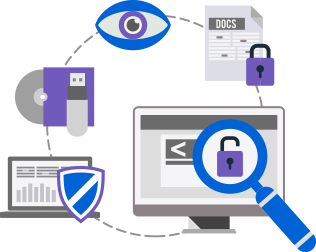
Given the many motivations that seem to remain the same, insider threats to an organization can be separated into three exclusive types. The following may help security advisors and information security personnel in staying up to speed with these types of insider threats.
Insider threat is a person who, for various reasons, may pose a threat to the security of an organization. In the past, this person may have had access to confidential, classified, or sensitive company data, and usually would be willing to sell that information to competitors for a profit.
But all this would happen in a non-digital environment, where the actual act of data theft would involve physically removing information in paper form (e.g. files, folders, etc.).
As time passed and brought us all into the digital sphere, insider threats have seen to become more frequent given the ease of accessing company data over a wide infrastructure of networks. But with the increase in threats, the exposure to various occurrences of data theft inside organizations and the many ways of executing such acts has exposed information security professionals to the pattern of such incidents as well as the insider behavior.
The main motivation has come to be seen as a wide contrast of elements that push insiders to do what they do. Reasons include either making money off of company data, for personal ideology, or to feed the ever increasing ego of insiders. Some insiders even do it just to bully their way up the success ladder.
It is by gaining an understanding of these motivations, security infrastructure inside organizations integrated personnel information security applications and programs to help weed out potential insider threats. A san example of how this kind of a security program may fit is when an employee in need of serious financial help, may be provided restricted access to certain sensitive information.
With the digital world, the threats have become even more sophisticated, with less chance of being detected. For instance, an outsider threat may use a USB thumb drive to wreak havoc in an organization. This may be done by placing the USB thumb drive in a common place inside the company’s premises. An employee of the company may then find it and decide to plug in the USB flash drive into a computer to find out who the owner is. As soon as the employee plugs in the USB flash drive, it installs a malicious program, leading to the organizations network being compromised.
With a capable data protection system in place, organizations can assure their data is secure and protected at all times by using software that blocks any external portable device, including USB flash drives. Data protection software that enables data security administrators to safeguard organization data over networks or individual computers will save unnecessary costs associated with implementing other large-scale enterprise network security mechanisms, and can provide them with the means to block all unwanted and unauthorized external devices, protect data from leaking through active password protection of data on computers, prevent data loss with multi-layer patent-pending protection that even works on Windows, prevent access by all external storage devices including USB drives, digi-cams, memory cards, maximize data protection through a DLP & copy protection software that ensures complete privacy of your sensitive data, and monitor any hack attempts and access through comprehensive logs & reports that monitors and reports on activities from all devices.
Whatever the motivation of the inside threat, the eventual end result is a clever of violating the security practices for nothing more than a personal gain.
Implementing feature-rich data leak prevention mechanism that blocks access to unauthorized USB drives, external drives, memory sticks, digital cameras, media discs, Blu-ray discs, network drives, network computers, and non-system drives, yet allows to maintain a list of all authorized devices helps prevent illegal copying and duplication of your organization’s sensitive data and information.
Preventive Measures To Avoid Data Leakage

1. Establish a comprehensive data security policy: Develop and implement a comprehensive data security policy that outlines the rules and regulations for data access, storage, and transmission.
2. Educate employees: Make sure employees are aware of the importance of data security and the measures they can take to protect it.
3. Utilize encryption: Encryption is one of the most effective ways to protect data from unauthorized access.
4. Implement access control: Implement access controls to limit who can access sensitive data.
5. Monitor networks: Monitor networks for suspicious activity and implement measures to detect and prevent malicious activity.
6. Use secure networks: Use secure networks for data transmission and storage.
7. Backup data: Regularly backup data to ensure that it can be recovered in the event of a breach or other disaster.
8. Update systems: Update systems regularly to ensure that they are secure and up-to-date.
9. Test security measures: Regularly test security measures to ensure that they are effective.
10. Educate users: Educate users on best practices for data security and privacy.
Use Of Data Leakage Prevention(DLP)
Data leakage prevention (DLP) is a technology used to identify, monitor, and prevent the unauthorized transfer of sensitive or confidential data. It is used to protect organizations from data breaches and other security threats. DLP solutions can monitor network traffic, detect suspicious activities, and block or alert on unauthorized data transfers.
Types Of Data Loss Prevention
Common types of data loss prevention include data encryption, data masking, data access control, and data loss prevention software.
First Step Of DLP Strategy
The first step of a DLP strategy is to identify and classify sensitive data. This involves understanding what data needs to be protected and why, as well as where it is located. Once this is done, organizations can then move on to implementing the appropriate data loss prevention measures.
Preventive Methods For Data Loss
1. Data Encryption: Encrypting data makes it difficult for unauthorized users to access it.
2. Data Masking: Data masking involves obscuring sensitive data so that it is not readable by unauthorized users.
3. Data Access Control: Data access control involves restricting access to sensitive data to authorized users.
4. Data Loss Prevention Software: Data loss prevention (DLP) software is designed to detect and prevent the unauthorized access or transfer of sensitive data.
5. Network Security: Network security measures such as firewalls and intrusion detection systems can help protect against data loss.
6. Employee Training: Educating employees on data security best practices can help reduce the risk of data loss.
7. Physical Security: Physical security measures such as locks and surveillance cameras can help protect against data loss.
8. Audit Trails: Audit trails can help identify any unauthorized access to data.
9. Encrypted Backups: Encrypted backups can help protect against data loss in the event of a system failure.
Different Types Of DLP Tools
1. Network DLP: Network DLP tools monitor network traffic for suspicious activity and can detect data exfiltration attempts.
2. Endpoint DLP: Endpoint DLP tools monitor endpoints for suspicious activity and can detect data exfiltration attempts.
3. Cloud DLP: Cloud DLP tools monitor cloud services for suspicious activity and can detect data exfiltration attempts.
4. Application DLP: Application DLP tools monitor applications for suspicious activity and can detect data
exfiltration attempts.
5. Database DLP: Database DLP tools monitor databases for suspicious activity and can detect data exfiltration attempts.
6. Email DLP: Email DLP tools monitor emails for suspicious activity and can detect data exfiltration attempts.
7. File DLP: File DLP tools monitor files for suspicious activity and can detect data exfiltration attempts.
8. Mobile DLP: Mobile DLP tools monitor mobile devices for suspicious activity and can detect data exfiltration attempts.
Best Prevention For Data Loss
The best prevention for data loss is to implement a comprehensive data loss prevention (DLP) strategy.
Working Of Data Loss Prevention Software
Data loss prevention (DLP) software works by monitoring and controlling the movement of sensitive data. It does this by scanning for data that is leaving the organization, and then blocking or alerting on any suspicious activity. This can include blocking emails with sensitive data, preventing data from being uploaded to cloud storage, or preventing data from being copied to a USB drive.
Main Objectives Solved By DLP
1. Identify and classify sensitive data: DLP solutions help organizations identify and classify sensitive data, such as credit card numbers, Social Security numbers, and other confidential information.
2. Monitor and control data movement: DLP solutions can be used to monitor data movement and control how it is accessed and shared. This includes blocking emails with sensitive data, preventing data from being uploaded to cloud storage, or preventing data from being copied to a USB drive.
3. Enforce data protection policies: DLP solutions allow organizations to enforce data protection policies and ensure that sensitive data is not shared with unauthorized users or accessed in an unauthorized manner. They can also help organizations detect and respond to data breaches.
Example Of Data Leakage
An example of data leakage is an unauthorized user gaining access to confidential information such as customer data, financial records, or intellectual property. This could be done through hacking, phishing, or other malicious activities.
